Over the past two days, we've already seen eight games. That's 16 teams competing across 12 hours of regulation play, plus the massive amounts of extra time the refs have been adding on to the end of each match in some sort of effort to prevent time-wasting, which seems to only encourage more time-wasting and injury risk, but that's neither here nor there. No, the point is this is a condensed World Cup in the middle of the club soccer season, so there have been more matches than there usually are at this point in the tournament.
It's hard to keep up! So, I'm here to give you the rundown on all of the teams that have played a match already, and then I'll be back again in two days to do it again for everyone else.
For each of the 16 teams with a game in the books, this is what we're wondering: What's the one question that will define the rest of their World Cup?
Group A
 Netherlands: Don't you guys need a midfield?
Netherlands: Don't you guys need a midfield?
When I previewed the tournament, I wrote about how the international game -- with its lack of aggressive defending and its slower pace of play -- provided a platform for midfielders to shine. Unlike in club soccer, with its comparative focus on fast transitions and winning the ball high up the field, the ball rarely gets turned over before it gets to the midfield, and then it rarely quickly bypasses the midfield. The ball just spends more time in that area of the field.
Against Senegal, though, the Netherlands played with two midfielders who don't do anything defensively and who impact the game with their off-ball movement more than their passing. The game looked something like this: The Dutch would cycle possession sideways across their backline, eventually get frustrated they couldn't progress the ball through the midfield, send the ball long instead and lose possession. Then Senegal would move the ball upfield at ease because no one in the midfield could stop them. Louis van Gaal's team had 54% of possession, but when you adjust for only possession in the final third (also known as "field tilt"), that number drops down to 45%.
While the Dutch came into this game on a real hot streak and looking like outside favorites for a deep run, they won't be around for long if they keep playing like this.
Rob Dawson feels Qatar will be disappointed with their performance in the opening game of the World Cup vs. Ecuador.
 Senegal: Can someone create something better?
Senegal: Can someone create something better?
The less talented of the two sides, the African champs did well to control Monday's game in the way mentioned above. Beyond the field tilt, they registered 23 touches in the opposition penalty area and only conceded 18, and they outshot the Netherlands 15-10.
- World Cup 2022: Schedule, how to watch
Of course, they, you know, lost the game. A couple of nice finishes from Cody Gakpo and Davy Klaassen won it late for the Netherlands, but the match was basically dead even in terms of expected goals, which measures the probability that a given shot gets converted into a goal. The shots on this map are sized by the quality of the chance:
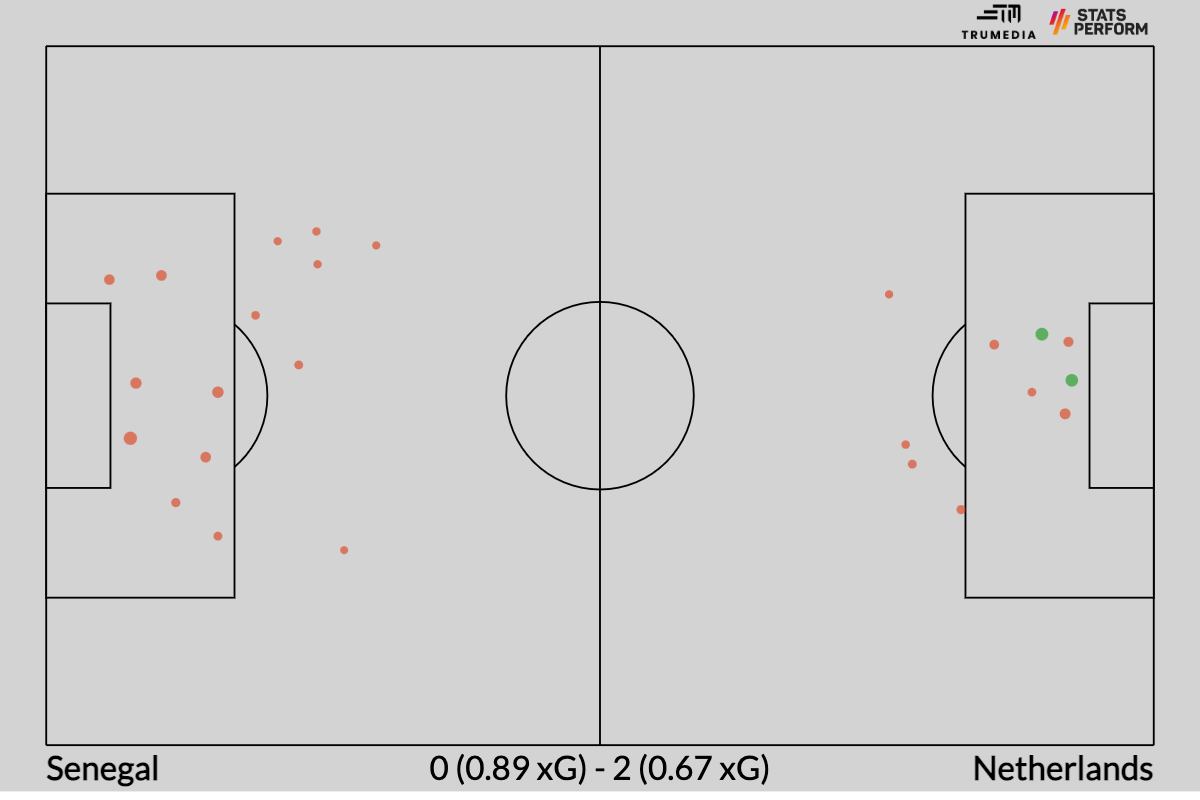
The main reason Senegal didn't turn that field control into a better result is that they only created bad chances. The average xG value of their shots was 0.059 -- meaning, a given shot had a 5.9% chance of becoming a goal. For context, the Premier League average this season is 10% per shot.
Senegal lost superstar forward Sadio Mane to injury just days before the tournament began, and they still haven't quite figured out how to replace him.
 Ecuador: Is that it?
Ecuador: Is that it?
Ecuador easily won their match against Qatar, but prior to Sunday, this team hadn't scored more than a goal in a game since Nov. 16 of last year. Nothing about this one suggested they've fixed their issues, either. The first disallowed goal came off a massive keeper error. The first actual goal came off a slightly smaller keeper error, and the second actual goal came from a low-probability header by their journeyman 33-year-old striker Enner Valencia -- who, to be fair, has been tearing up the Turkish league this season.
The game was over by the 31st minute, and they seemed to take their feet off the gas, but they also only attempted six shots across 90 minutes against ...
Gab Marcotti says England can only take positives after an impressive attacking display in their 6-2 win vs. Iran.
 Qatar: The worst team ... ever?
Qatar: The worst team ... ever?
This team just looks freaking terrible, and what should we expect? They're only in the tournament because [insert geopolitics and FIFA corruption here... seriously]. Underdogs have historically beaten better teams by defending deep and then hitting them on the counter. Qatar, instead, seem dead-set on playing a Spain-esque possession game despite not having any players who can do anything with the ball since they -- I don't know, pick a reason -- have a smaller population than the state of Mississippi.
So, you get a pass map that looks like this:
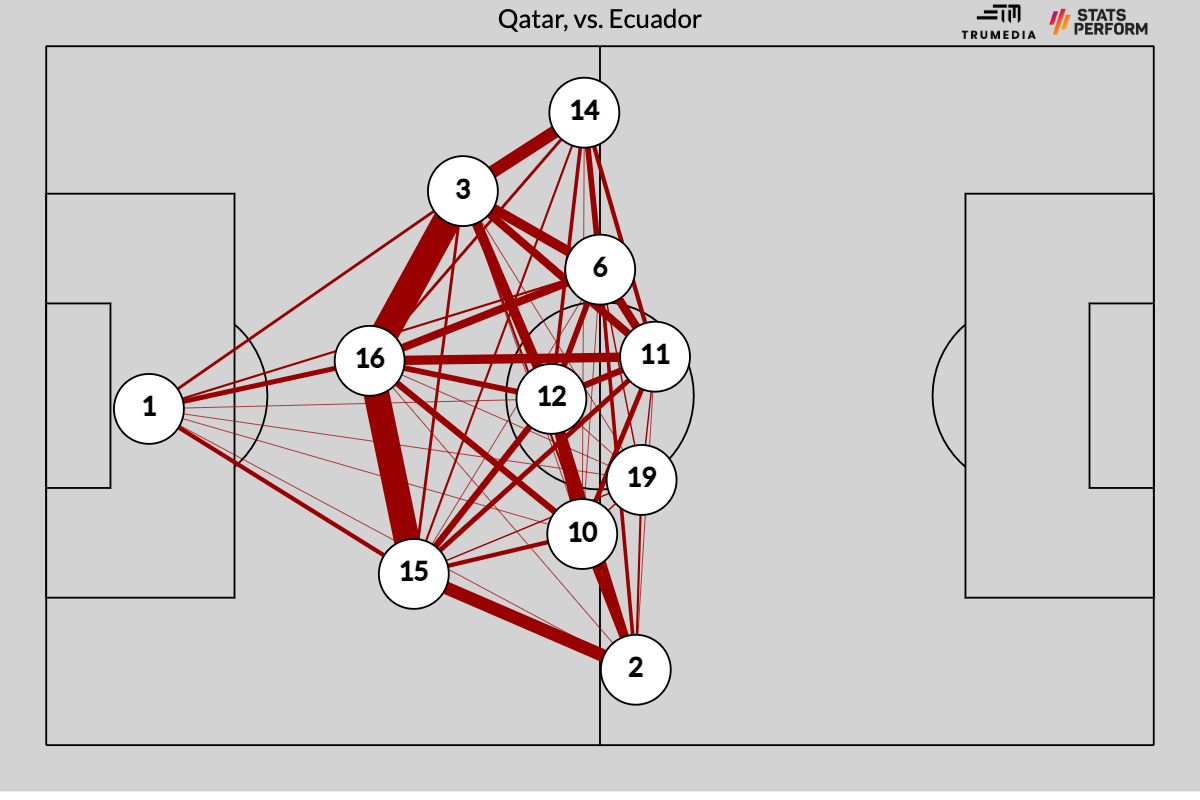
Someone want to tell them the goal isn't on the sideline?
Ecuador couldn't buy a goal for a year and then beat the hosts without breaking a sweat. The worst group stage performance at a World Cup came from Saudi Arabia in 2002: no points, zero goals scored, 12 goals conceded. Something similar is definitely in play for the hosts.
Group B
 England: Will they keep this lineup together?
England: Will they keep this lineup together?
The main problem with Gareth Southgate's tenure as England manager is the same one that has afflicted most professional coaches across the history of professional sports: He tends toward conservative choices. Despite boasting arguably the best collection of attacking talent in the world at his disposal, he has frequently opted to play a system with five defenders, which by definition means one of those great attackers doesn't see the field.
Not against Iran, though. Southgate went with a standard back four and then a pair of midfielders that featured Jude Bellingham, who was constantly breaking forward into the penalty area. Ahead of them, there were four more attackers. England absolutely pummeled an Iranian team that had conceded just 0.4 goals per game across their last 10 competitive matches before the World Cup. Except, England also conceded a bunch of late chances and two soft goals.
After the match, Southgate seemed really frustrated to lose the shutout, despite the 6-2 win. With a theoretically tougher opponent in the USMNT up next, will he trust his attackers to take over again? Or, as he's done in the past, will he revert back to a more conservative setup that potentially raises their floor and definitely lowers their ceiling?
Dale Johnson explains why Denmark were not awarded an injury-time penalty vs. Tunisia despite a VAR review.
 Iran: Do they have to change it up?
Iran: Do they have to change it up?
Although he's given credit for helping modernize Manchester United's tactics after the turn of the century as an assistant to Sir Alex Ferguson, Carlos Queiroz's recent history as an international manager has favored this approach: sit deeper and deeper, grind our opponents into dust, hope we're slightly better at kicking the ball into the goal than whoever's on the other side of the field, and make everyone watching our games question why they ever thought this sport was any fun to begin with. It's like the Grit 'n' Grind Memphis Grizzlies, but without any of the charisma.
Well, the defense fell apart against an England team that's struggled to score goals over the last year, and now they're playing catch-up against both the U.S. and Wales, too. These guys have a ton on their minds right now; who knows how that's affecting everything. But if your defense isn't what you thought it was and you need to maximize your potential points over the next two matches, then Queiroz Ball might not be the way forward -- if it ever was.
 United States: Who's the No. 9?
United States: Who's the No. 9?
You can't boil the USMNT's problems against Wales down to one thing, but if you really wanted to, then it would be: They didn't have a striker. After going 14 months without attempting one for the U.S., Josh Sargent did register a shot against Wales, and he did play a role in Tim Weah's goal -- but that's about it.
In the first half, the USMNT were totally dominant off the ball. They pressed really high and forced long balls that both center-backs and defensive midfielder Tyler Adams mopped up with ease. They also held 66% of the possession, though it was even more lopsided than that: The field tilt was 76% in favor of the Americans. They scored a great goal from the best open-play chance of the game ... but again, that was it.
Despite flipping the field like a top-level club team, they only attempted three shots worth 0.66 expected goals. The guy who's supposed to get the shots simply wasn't involved in the game:
Josh Sargent up front. ¯\_(ツ)_/¯#USMNT pic.twitter.com/st4M6siaHf
— Between The Posts (@BetweenThePosts) November 21, 2022
In the second half, Wales took control of the match, outshooting the Americans and flipping the field in their favor: 53% field tilt. For much of the half, the USMNT seemed between two minds: They weren't committed or were unable to press as high after halftime, but they also weren't fully bought into defending deeper and attempting to counter.
Wales had no trouble moving the ball upfield and no trouble moving it into the penalty area; you should be able to prevent at least one of the two from happening. However, counter-attacks are way less effective when one of your attackers isn't providing any kind of threat. In the second half, Sargent and his eventual replacement Haji Wright combined for 13 total touches -- fewer than every Welsh player other than Brennan Johnson, Joe Morrell and Sorba Thomas, who played 13 minutes combined.
There were some really exciting moments and promising stretches for the USMNT, but this team just isn't good enough to carry one of its 11 starters and still outplay World Cup competition. While he wasn't scoring a ton of goals in qualifying, the starter-up-until-just-now Jesus Ferreira is always involved in the game. And if not him, maybe it's time to try Timothy Weah up top and get at least one of the European guys -- Giovanni Reyna, who claims he's fully healthy, or Brenden Aaronson -- on the field from the jump.
 Wales: What happened in the first half?
Wales: What happened in the first half?
Someone who works in European soccer once told me that he thinks the secret to the sport is figuring out a way to get your players to play like they're losing ... for the whole game. So many sides, even the best ones in the world, will concede more chances as soon as they take the lead and create more as soon as they go behind.
These dynamics, of course, work in concert, but it should never get to that point -- should it? The way to ensure that you win is to score a second goal, not concede space and opportunities to your opponent. And, well, the way to win, more broadly, is to score the most important goal in the game: the first one. This psychological swing is perhaps the overarching story of the U.S.-Wales game. Wales wanted to play conservatively, which encouraged the U.S. to play aggressively ... until they scored. Then the U.S. started playing conservatively, Wales was forced to play aggressively, and boom, tie game.
However, Wales manager Rob Page made a substitution at halftime, replacing winger Dan James with gigantic center-forward Kieffer Moore. That could also be an explanation for the improvement over the second 45. We'll likely see Moore from the jump against Iran, but will Wales' second half carry over to the first half of the next match?
Group C
 Saudi Arabia: Can the high line continue?
Saudi Arabia: Can the high line continue?
The Saudis just pulled off one of the biggest upsets in modern sports history. Per ESPN Stats & Information research, only three winning underdogs -- New Jersey Institute of Technology over Michigan in college basketball in 2014, and Idaho State over Nevada and Liberty over Baylor in college football in 2017 -- had longer odds. They did it, generally, in the same way these soccer underdogs always do: have two players hit a ball more purely than they ever have before, and then hang on for dear life.
However, for much of the match, they didn't do the thing most other underdogs do: defend deep. Instead, they drew Argentina offside a whopping 10 times over the course of the match.
45 mins in: "what are you thinking with that high line?!"
— Opta Analyst (@OptaAnalyst) November 22, 2022
FT: "Hervé Renard, football genius!"#ARGKSA | #FIFAWorldCup pic.twitter.com/EBvCZZNu4O
After Lionel Messi opened the scoring with an early penalty, Saudi Arabia conceded three more goals in the first half that were then ruled out for offside, and perhaps with FIFA's new automated offside system, this is the right approach. It seems like the system is designed to favor the defense and pick up on even the slightest discrepancies in player positioning. But man, they were cutting it as close as possible.
What do they care, though? Per FiveThirtyEight, they're 2-to-3 to make it to the next round now.
 Argentina: Will they panic?
Argentina: Will they panic?
Here's the thing about soccer: it's a bunch of people trying to kick a ball past one other person who can use his hands. They also then have to build the capacity to get in position to take those shots while the other team is simply just trying to destroy their capacity. Put another way, what's easier: painting The Garden of Earthly Delights, or smashing the artwork with a hammer? It's really hard to score goals, and because of that, a lot of random things can happen over the course of a single 90-minute match.
That's, essentially, what happened on Tuesday morning. Argentina created a ton of great chances, conceded three low-probability shots ... and lost the game 2-1. The expected-goal tally for the match puts an even finer point on the absurdity:
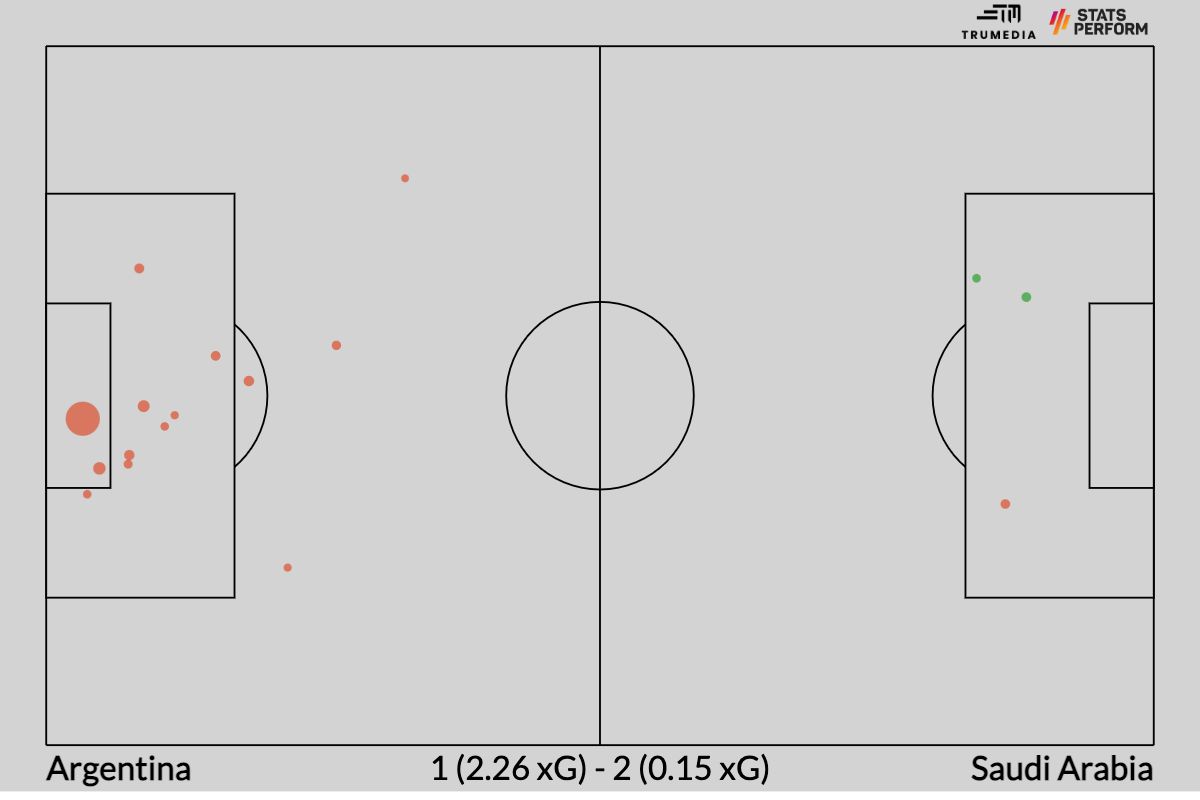
Throw in all of the disallowed offside goals, which were quite literally centimeters away from counting, and it looks even more ridiculous. Argentina win this exact game with these exact chances, I don't know, 99 times out of 100.
If there were any problems with the performance, I'd say it's two-fold. Saudi Arabia won possession six times in the attacking third, while Argentina did the same only twice. The opposite, generally, should be true when you're the better team and when you're chasing the game. The other concern is that -- of all those chances -- they generated only 0.29 xG from open play.
If we work from the premise that Argentina created more than enough chances to totally dominate, then those are both nitpicks. And even though they lost, I think they're both still nitpicks. All of the great chances from the ruled-off goals were from open play; plus, they have Lionel Messi, so open-play shot creation shouldn't ever be a problem. Their effectiveness from set pieces probably bodes well for the future in a lot of ways.
So, the challenge here for Lionel Scaloni is the same challenge for any coach who oversees a team with healthy fundamentals that briefly gets sidetracked by some noise: to stay the course. Argentina are in a hole now. Their odds of getting out of the group, per FiveThirtyEight, dropped from 84% to 54% after the result. But despite the historic nature of the defeat, the worst thing Argentina could do right now would be to mix things up.
 Mexico: Will the Memo Show get an encore?
Mexico: Will the Memo Show get an encore?
Death, taxes and Memo Ochoa ascending to a higher plane of existence every four years as soon as he puts on a Mexico shirt.
I've told you about expected goals, but Stats Perform also calculates something called expected goals on target. While xG refers to where the shot is taken from, xGOT looks at where the shot ended up on the goal frame. Using that info, you can adjust for the difficulty of the shots a keeper is facing and then determine, roughly, how many goals he has saved compared to the average keeper.
Since 2014, Ochoa has saved 5.38 goals above average: no other keeper is above 4.75. Orange are goals; the bigger the circle, the harder the save.
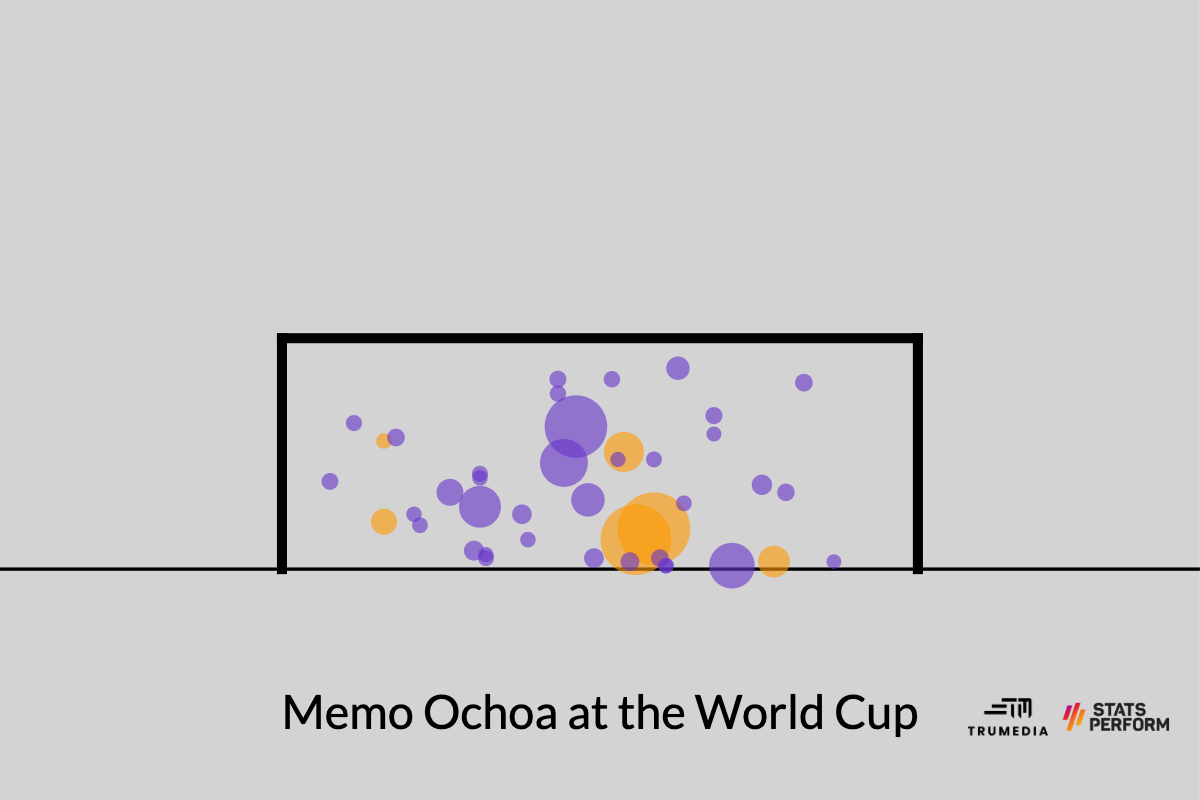
He saved a penalty against Poland, and he's likely going to have to do it all over again when Mexico take on Argentina this weekend. If he can, though, Mexico will take two (or even four points) into a win-and-you're-in final group stage match against a Saudi Arabia team they should beat.
 Poland: Uh, guys?
Poland: Uh, guys?
Robert Lewandowski is arguably the best centre-forward in world soccer. He has averaged almost 32 goals per season over the past seven seasons. And he has still ... never scored at the World Cup.
The streak continued after Ochoa saved his penalty, and outside of that attempt, he took only one other shot against Mexico -- a header from a corner that missed the target. Save for the penalty, Poland as a whole created barely anything in the 0-0 draw. This team just hasn't even come close to making the most of a generational talent at the most important position in international soccer.
At Borussia Dortmund, Bayern Munich and now Barcelona, Lewandowski has flourished in teams that made peace with playing in wide-open matches with lots of turnovers. Yet Poland have waffled between playing conservatively and springing chances on the counter, or pairing their star striker with other strikers who like to occupy the same positions in the penalty area as he does.
This is no soccer powerhouse, but they have a bunch of other players (Piotr Zielinski, Arkadiusz Milik, Wojciech Szczesny) who play in Europe's best leagues. They shouldn't be this toothless, but if the Mexico game is any indication, they still are.
Group D
 France: Is anyone better?
France: Is anyone better?
A couple of years ago, the consultancy Twenty First Group published a study that found that the more talented team wins more matches when the game features more chances for both sides. When there were limited shots for both teams, variance played a bigger role. In other words, when the game was open, the favorites won way more often.
This idea flies in the face of most international managers -- and the result of the 2018 World Cup, too. Up through the final, people -- including me! -- were complaining about how France never released the emergency brake, played too many defensive players and ground out wins instead of trying to blow their opponents off the field. Of course, they won the World Cup anyway.
Even with all of their injuries now, France are probably still the most talented team in the world, and so the only real reasons to doubt them were either (A) the intrasquad drama that seems to sabotage their chances every other World Cup, or (B) conservative personnel choices from the manager.
Well, against Australia, Didier Deschamps went for a more attacking lineup than we're used to. Three of the front four were the same from 2018, but Blaise Matuidi -- a defensive midfielder deployed as a winger -- was replaced by an explosive, two-footed attacking winger in Ousmane Dembele. Then, at center back, the rangy, aggressive, proactive and progressive pair of 24-year-old Ibrahima Konate and 23-year-old Dayot Upamecano replaced the more traditional defenders from 2018. Still, Deschamps continued with the pair of defensive full-backs (Benjamin Pavard and Lucas Hernandez) from 2018.
France gave up an early goal, and Hernandez was injured in the process. He was replaced by his brother Theo -- one of the most aggressive attacking full-backs in the world -- and France went on to absolutely overpower Australia in one of the most dominant performances of the Deschamps era.
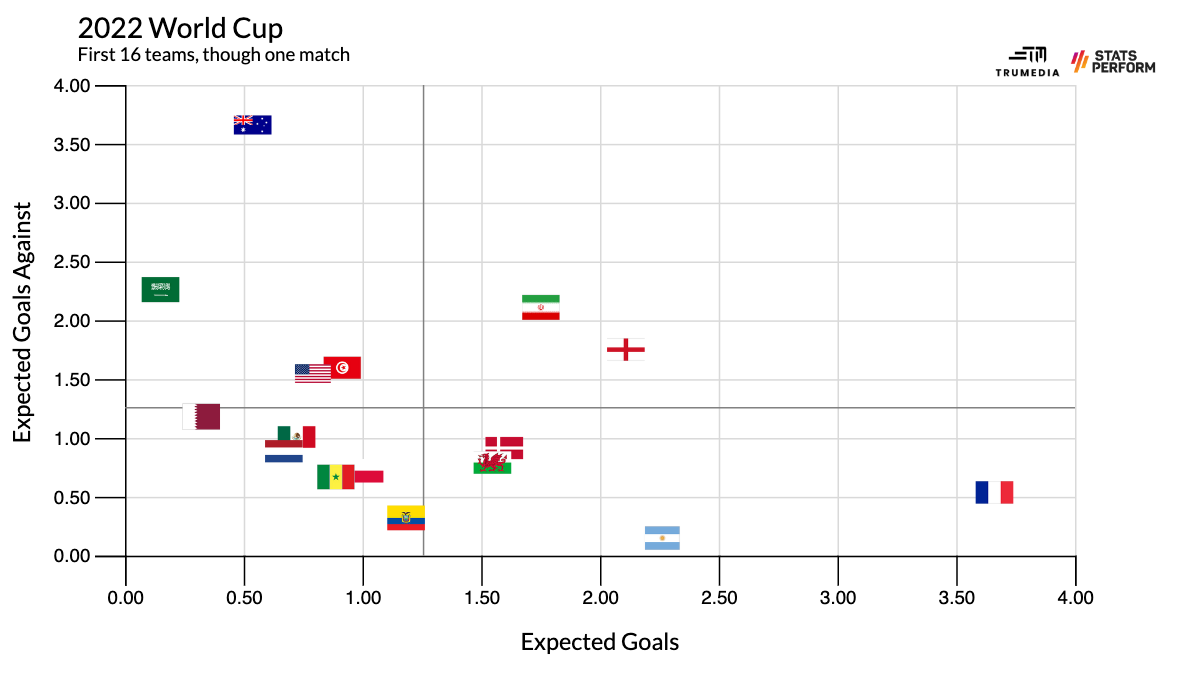
Sure, "it's Australia" or whatever, but this is the France so many of us have always wanted to see. Will they keep playing this way with these players as the tournament progresses? If they do, they are -- in my opinion -- the new favorites to win the whole thing.
 Australia: It can't get any worse ... right?
Australia: It can't get any worse ... right?
 Denmark: Four or three?
Denmark: Four or three?
As the Argentina section suggests, I'm not too concerned yet with the score lines of these matches, beyond how they affect the likelihood of a given team advancing. What matters, more, is how many chances a team creates and how many it concedes. That's a bit more predictive of what's likely to happen going forward -- albeit still not all that predictive, either -- but through that prism, Denmark were the most disappointing team from the first three days of games.
After making a run to the semis of the Euros and then cruising through World Cup qualifying, the Danes came into the tournament looking like, at worst, the best team outside of the group of nine favorites including the two South American giants and the European septet of France, England, Spain, Germany, Portugal, the Netherlands and Belgium. They then proceeded to get outshot 11-3 by Tunisia over the first hour of their match.
Soon after, manager Kasper Hjulmand switched from a back five to a back four and things suddenly looked a lot better, as evidenced by this chart:
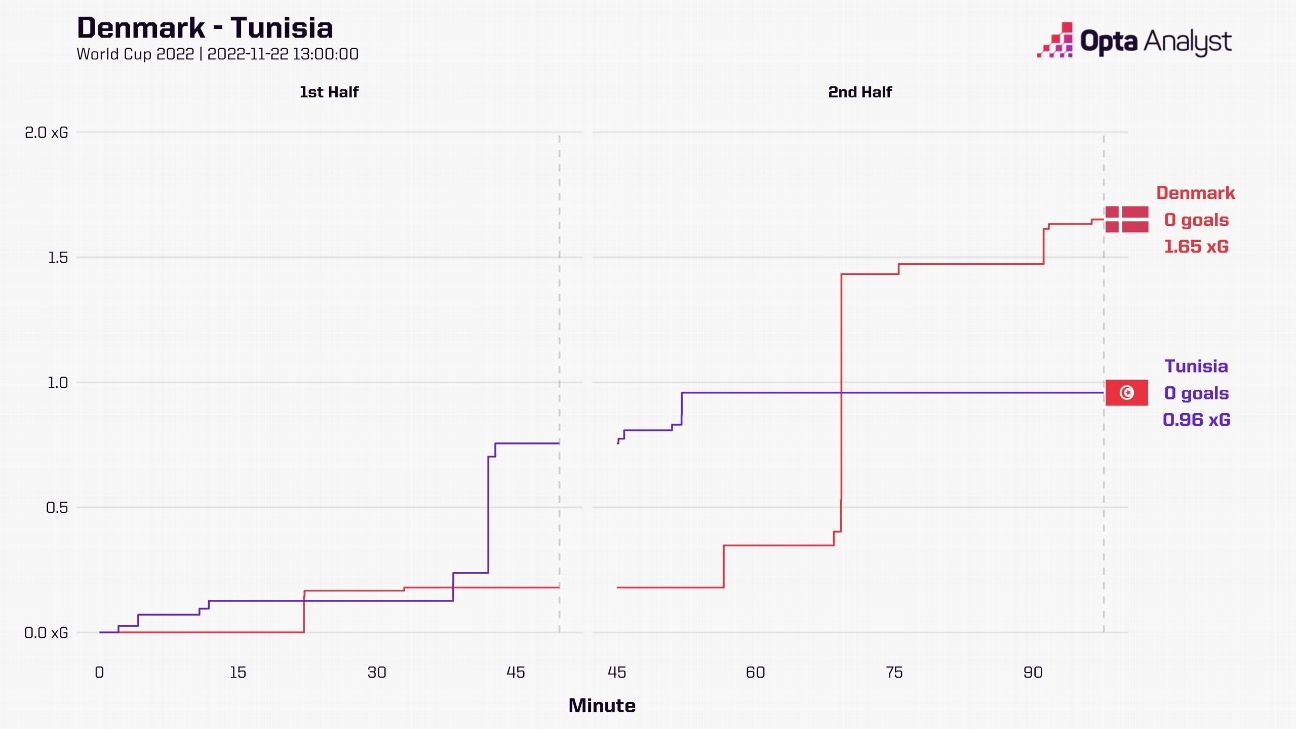
Was the real Denmark, then, the one we saw over the last 30? Or the first 60?
 Tunisia: Can you figure out set pieces?
Tunisia: Can you figure out set pieces?
See all that xG that Denmark pumped out by the end of the match? A full 1.27 of it came from set pieces -- more than any other team generated from set pieces in the tournament so far. As I wrote last week, the set piece revolution began in Denmark at FC Midtjylland and then spread throughout the rest of the league, so it's no surprise that the Danes have the slickest routines at the tournament.
So if we just accept that Denmark would produce like this against anyone, then we're left with the fact that Tunisia conceded just 0.3 xG from open play against one of the better teams in Qatar.
If they keep that up against Australia and against France, four or five points from three games is certainly in play, and that's usually enough to advance. But if the weakness from set pieces is more of a "Tunisia bad" than "Denmark good" thing, then it's really hard to see this team having enough attacking firepower to make up for the chances they're likely to concede over the next two games.
